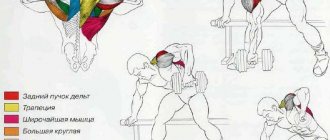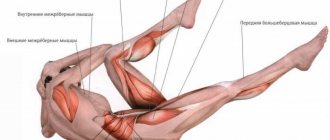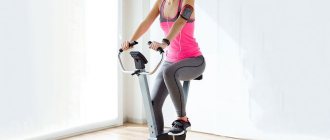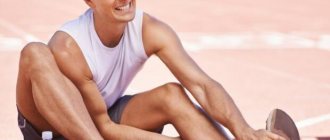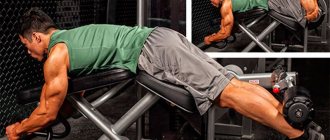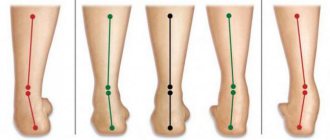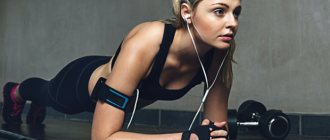There are quite a lot of exercise machines that are compact in size, but can make working on the body much more effective. One of them is the abdominal roller, exercises with which are aimed at strengthening the abdominal muscles, but also allow you to work with other muscle groups. Not only trained athletes, but also beginners taking their first steps in the world of sports can perform exercises with the simulator.
The exercise machine can be found in almost any sports store or purchased online. The names may be different: abdominal roller, abdominal wheel, sports wheel, gymnastic wheel, gymnastic roller. In fact, these are names of the same simulator.
What is a simulator?
The ab wheel fully lives up to its name. In essence, this is a wheel with handles attached on both sides. The simulator can have one or two wheels or provide the ability to install/remove an additional wheel. The diameter may vary, but usually ranges from 15-20 cm (the smaller the diameter, the more difficult it is to practice). The simplest models have ordinary plastic handles, while the more advanced ones have rubberized handles, which is much more convenient and safer when practicing.
Modernized models can be equipped with foot pedals, which allow you to expand the list of exercises and work more actively on the lower body. You can also purchase a wheel trainer with handles, which will have a built-in trimmer with tensioners (expanders).
What to look for when choosing
When purchasing a gymnastic roller, it is important to correctly assess your capabilities and needs, as well as analyze product offerings on the market. This is necessary in order to buy a simulator specifically for your level, and also not to succumb to the tricks of consultants in stores, for whom sometimes it is much more important not to help the client find a suitable option, but to sell him a more expensive model.
A trainer with a return mechanism is the best option for beginners. It makes training easier and minimizes the risk of injury. But unlike a simple wheel that does not have a similar function, it does not produce such a high load.
Working out with an ab wheel that has two rollers is much easier than with one. This type of exercise machine maintains balance better, although it makes the load lighter.
A roller with a shifted center of gravity is more suitable for those who already have experience with a simple wheel and are ready for more complex loads. This model is not recommended for beginners.
When choosing, you should pay attention to the weight of the wheel. Light weight models are easier to work with, heavier ones are more difficult.
A wheel with pedals is usually chosen by those who exercise professionally. This simulator allows you to significantly diversify the set of exercises with it and get the best results. Even more options for performing exercises are provided by the simulator, which is additionally equipped with a trimmer with tensioners. It allows you to increase loads by using cable tension.
Benefit
It seems to be a simple mechanism, and the price of an abdominal wheel is not high, but almost every professional athlete includes exercises with it in their program. This is due to the effect it gives.
The peculiarity of performing exercises with it requires the athlete to have high strength indicators and constant control over the movement of the wheel.
The range of motion causes the muscles to tighten as much as possible at the moment of greatest stretch. Thanks to this, it is possible to work on fabrics better and deeper, making them stronger and more prominent.
During operation, the main load falls on several areas. The abs are the hardest, then the shoulders, then the back and core muscles.
Because of this, regular wheel training can improve overall core strength, strengthen shoulder joints and support the spine.
Since there is no need to bend the spine, the lumbar region is less susceptible to injury and possible problems with cartilage tissue.
On the contrary, constant and low-intensity compression work makes tissues stronger and healthier.
The abdominal fitness wheel was invented during the golden era of bodybuilding. If you want, you can even make it yourself, but of course it’s much easier to buy it in a store.
Beginners and lovers of everything unusual will be surprised by what manufacturers provide them with. There are models in which it is possible to control the load due to the return mechanism and resistance.
They also let you know how many reps you've done thanks to a miniature dashboard.
The appearance of the handles has also changed, which can be placed in different positions, thereby changing the focus of the load.
What muscles are strengthened when working with a simulator?
Ab roller exercises are aimed at working primarily the upper body, namely the arms, shoulders, abdomen, back and chest. But when they are performed, a significant load is also placed on the muscles of the lower abs and lower back; the buttocks, quadriceps and hamstrings are additionally involved.
When performing exercises with a wheel in the “plank” position, almost no part of the body is left without load. A wide range of options for using the simulator also allows you to work on hidden muscles, while achieving the best results.
Exercises with the wheel are also recommended for those who are too early to think about working out muscles and simply need to lose excess weight.
How to pump up your abs and other muscles using a wheel
There are quite a few exercises that use a gymnastic wheel. The principle of operation is always almost the same, but the starting position changes.
Down on my knees
Holding the handles of the roller with straightened arms, rest it on the floor and place it strictly under the shoulders. Slowly begin to roll the wheel forward to the distance of outstretched arms, and just as slowly return to the starting position. This is the simplest option, but quite effective for working out the abs. To work on the oblique abdominal muscles, a similar exercise is performed, but the roller does not roll forward, but slightly to the side of the body.
Down on one knee
In this case, the second leg is moved to the side. The exercise is performed similarly to the previous one. It is also possible to roll the roller both forward and to the side.
Half-standing emphasis
Kneel with one foot, the other rests against a wall or other reliable surface. Holding the roller in your hands, roll it forward and backward as much as possible, keeping the center of gravity on it.
Standing emphasis
Feet shoulder-width apart, arms straightened, roller resting on the floor. Roll it forward as much as your physical training allows, then go back.
Sitting on my knees
Roll forward to a lying position, without lifting your knees from the floor, pull yourself back.
It is recommended to perform each exercise with an abdominal roller 10 times, doing 3 approaches. At the initial stage of training, the number of repetitions and approaches can be reduced. This is especially true for those for whom physical activity is unusual. It is best to exercise every other day, since the muscles need time to recover.
It is extremely important each time before you start using a gymnastic roller to warm up your body with simple exercises. This could be running, squats, bending, etc.
Exercises for Beginners
Exercises with a gymnastic wheel for beginners are included in the basic complex. When performing exercises, watch your breathing: inhale when bending down, exhale when lifting. You should not immediately do heavy loads, increase them gradually.
An approximate basic complex for beginners:
- We sit on our knees, hands on the handles of the roller. We push it forward, bending over, but without lifting the pelvis from the knees. The body rests on the hips. We return to the sitting position on our knees.
- Get on your knees and hold the roller in front of you. We smoothly push the projectile forward, stretching our body as far as possible, trying not to touch the floor. Hold in the extended position for 2-3 seconds and slowly return to the starting position.
- Lie on your stomach, arms outstretched with the roller in front of you. Slowly pulling the exercise machine towards you, we lift the body with a deflection. Smoothly return to the lying position.
- Sit on the floor, legs straight, gymnastic wheel on your right side. With both hands we take hold of its handles and roll it away, gradually turning the body. We bend down as low as possible without touching the floor, fix ourselves in this position and return to a sitting position.
Depending on your physical fitness, each exercise should be performed up to 8 repetitions. If it is very difficult, start with fewer executions. Start the number of approaches with 2, gradually increasing the load to 4.
Advantages of the roller over other simulators
Despite its simplicity, small dimensions and low cost, a sports roller has many advantages and can seriously compete with more complex and expensive exercise equipment. Its advantages include:
- Highly effective in strengthening the abdominal muscles, as well as general “drying” of the body and reducing the amount of fat deposits;
- By working on both the rectus and oblique abdominal muscles, the roller helps change its shape, making the abs toned and attractive;
- Increased endurance, improved posture;
- Does not take up much space, easy to assemble and operate;
- You can choose a simulator for different degrees of fitness and weight of the athlete, as well as the type of exercise.
What muscles work?
Well, to put it in a few words, all muscles. But still, let's take a closer look at the working corset.
Back. You won’t believe it, but the back muscles, and most of all those located along the spine (trapezius, latissimus, lumbar), receive a tremendous load when rolling back and forth. The peak of tension occurs at the lowest point, when it is necessary to keep the entire body straight.
Breast. Not as involved in the work, but still contributing.
Deltas (shoulders). Oddly enough, a huge load also falls on your shoulders - they are the ones who allow you to move the roller back and forth, and it depends on them whether you can do this or not.
Rectus and oblique abdominal muscles (abs and sides). Like the back, the abs receive quite a large load, because they are responsible for bending the body, and when lowered, they also stretch. The sides are not so tense during work - they play the role of stabilizer muscles, monitoring the balance of the body.
Muscles of the legs and buttocks. Even though the footwork seems obvious, it is not. The buttocks are even more involved in the work here than all the underlying muscles.
The muscles of the thighs and legs are stretched and tensed only statically, if this is a non-specific leg exercise (but we are discussing a basic exercise now, I will write about all the exercises tomorrow). The buttocks tense during flexion and extension of the hip joints, which also pumps them up enough.
Hands. As in the case of the legs, the arms are loaded only statically (biceps, triceps, forearms), being responsible for grip, holding the projectile and the position of the arms (bent or straight).
Small muscles of the neck. The neck is also involved in the work, but in general it does not contribute too much to the exercise, although if the neck muscles hurt, you will feel when lowering and rising exactly when they come into action.
Round, diamond-shaped and jagged. These small muscles obey the “older muscles” near which they are located. That is, if a nearby large group of muscles tenses strongly, then they will also be more involved in the work. And vice versa.
Skeletal. As you know, our body is not limited to the muscles that we can see. There are also skeletal muscles that also work quite well during this exercise. Typically, the roller allows you to train these muscles, although it is very difficult to achieve such an effect with conventional exercises with free weights or with your own weight.
Joints. Well, and of course, the joints to which the above-described muscles are attached receive enormous training and strengthening. You may not have outstanding muscles and large dimensions, but thanks to the strength of your joints, you can do what some “jocks” cannot. An example would be Bruce Lee.
Features of the exercises
When performing exercises with a gymnastic wheel, you must adhere to certain recommendations that will help you get the most noticeable results from your exercises:
- For those who are just starting training with a roller, it is better not to immediately get into the plank position, but to perform the exercises with emphasis on the knees;
- The wheel should move as smoothly as possible, without jerking;
- While the wheel is moving, the abdominal muscles should be in constant tension;
- In the final position you need to take a short pause.
- When performing the exercise on your knees, you need to place a special gymnastic mat under them to minimize the load on the joints.
There are a number of contraindications for training with a wheel. Traditionally these include:
- Spinal injuries and joint diseases;
- Presence of chronic diseases;
- Bad feeling;
- Pregnancy.
If pain occurs in the back and spine, it is recommended to stop exercising and consult with specialists.
Options for exercises with a wheel for beginners and for experienced ones
As we have already said, to perform this exercise it is necessary to create significant force (primarily with the press). And the further you roll the roller (the more you straighten), the more difficult it is to do this. Aerobatics lies in the ability to fully straighten up (and, of course, then return back).
If you feel that this option is too difficult for you, then you can perform this exercise while kneeling. This option is much simpler, and almost anyone can do it.
If, on the contrary, you want to complicate this already difficult exercise, you can try doing it using only one hand. But for this option, you will need an unusual roller, in which the handles are not located on the sides of the wheel, but, on the contrary, two wheels are located on the sides of one handle (essentially reminiscent of a dumbbell, but with a rotating handle).
We believe that this short article provides a complete and comprehensive answer to the question of abdominal wheel exercises for both men and women, and no further clarification is required on this issue. Therefore, let's not waste water.
Instead, we suggest you read our other article on the topic of training the abdominal muscles - “A set of abdominal exercises at home.”

